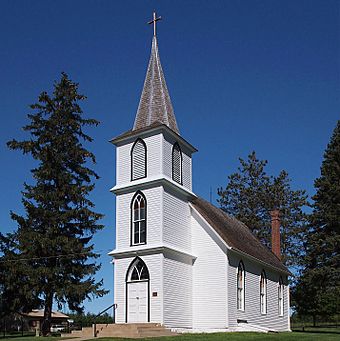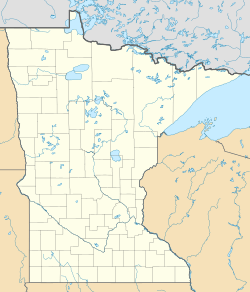Christdala Evangelical Swedish Lutheran Church facts for kids
Quick facts for kids |
|
|
Christdala Evangelical Swedish Lutheran Church
|
|

Christdala Evangelical Swedish Lutheran Church from the southeast
|
|
| Location | 4695 Millersburg Blvd., Forest Township |
|---|---|
| Nearest city | Lonsdale, Minnesota |
| Built | 1878 |
| Architect | John Olson |
| Architectural style | Gothic Revival |
| NRHP reference No. | 95000617 |
| Added to NRHP | May 18, 1995 |
The Christdala Evangelical Swedish Lutheran Church is a very old church in Forest Township, Rice County, Minnesota. It's about 11 kilometers (7 miles) west of Northfield. This church is special because it tells a story about early Swedish settlers. It also has a connection to a famous event from 1876. The United States Department of the Interior added it to the National Register of Historic Places in 1995. This means it's an important historical site.
Contents
A Church Built by Swedish Settlers
The Christdala church was started in 1877 by Swedish immigrants. These families came to Rice County to build new lives. They built the church in 1878 in a style called Late Gothic Revival. This style was popular for churches at the time. Church services stopped in 1966.
Later, in 1994, some people who used to be part of the church formed a group. This group, called the Christdala Church Preservation and Cemetery Association, works to keep the church and its cemetery in good condition. Today, the church is a reminder of the hard work of these Swedish-American settlers. They built a simple church and helped their community grow.
Important Dates in Christdala's History
How the Community Started
- 1856 – George Miller started a village called "Millersburg." He built a mill and a hotel. This brought new settlers to the area.
- 1870 – The first Swedish immigrants arrived in the Millersburg area. They came from places like Red Wing and Vasa. At first, they held church services in their homes.
- 1871 – A post office was set up nearby. More Swedish families moved into the area.
Building the Church
- 1876 – A Swedish immigrant named Nicolaus Gustafson was killed. This happened during a bank robbery in Northfield, Minnesota. The robbery was by a group known as the James-Younger Gang. Because the Swedish community didn't have its own cemetery, Gustafson was buried in Northfield. This sad event made the Millersburg Swedes decide to build their own church and cemetery right away.
- 1877 – The Christdala congregation was officially formed. Thirteen families helped start it. They received land from neighbors Peter Youngquist and Carl Hirdler. The church joined the Lutheran Augustana Synod.
- 1878 – The Christdala church building was constructed. John Olson and John Lundberg from Northfield built it for $230. The church building you see today is the original one. It has never been changed or moved.
Growing and Changing Times
- 1878 to 1918 – Many Swedish people moved to the United States, including Minnesota and Rice County.
- 1880 – A pulpit was built for the church. The inside walls were plastered. Oil lamps and the first organ were bought.
- 1881 – Front steps and horse stalls were built. A table, chairs, and a baptismal font were purchased. These items are still in the church today.
- 1882 – The Christdala congregation grew to 70 families. About 170 people attended church each Sunday.
- 1885 – The church adopted its own rules. More than half of the church's money was used for education.
- 1886 – A new organ was bought from Chicago. This organ is still used today.
- 1890 – The church had its most members, with 230 people.
- 1895 – A 60-foot (18-meter) bell tower was added to the front of the church.
- 1901 – A bell was placed in the bell tower.
- 1903 – The church started offering services in English once a month.
- 1917 – English became the only language used for services. New heating was installed. The original kneeling benches were replaced with 18 oak pews.
Preserving History
- 1927 – Christdala celebrated its 50th Anniversary.
- 1966 – The church had very few members left. The Christdala congregation officially closed.
- 1978 – A group was formed to take care of the Christdala cemetery.
- 1994 – The Christdala Church Preservation & Cemetery Association was created. This group raised money to fix up the church. They painted it, replaced the roof and windows, and fixed the front steps.
- 1995 – Christdala was officially added to the "National Register of Historic Places." This was done by the U.S. Department of the Interior.
- 2002 – Christdala celebrated its 125th Anniversary. The Preservation Association started a fund to help keep the church maintained forever.
- 2008 – Christdala bought the old Millersburg Schoolhouse. This building, built in 1887, is being restored. It will be used to store records and as a community museum.
More to Read
- Quist, B. Wayne (1996) The History of the Christdala Evangelical Lutheran Church (Dundas, Minnesota: Small World Press)



